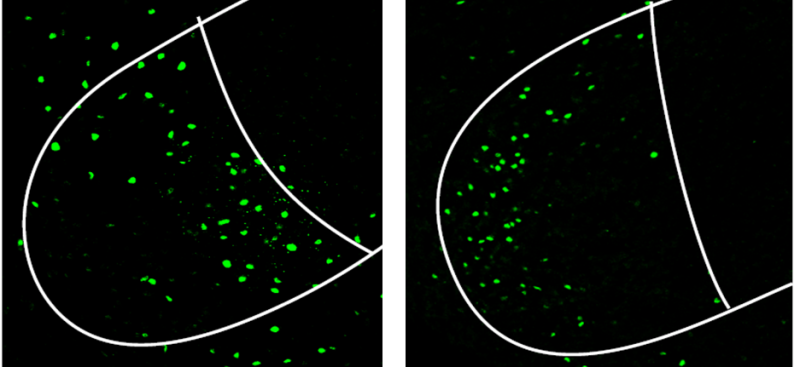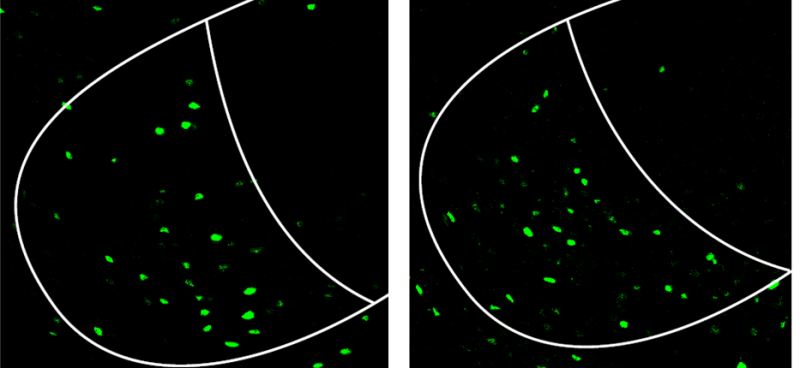Sex and aggression controlled separately in female animal brains, but overlap in male brains

Brain structures that control sexual and aggressive behavior in mice are wired differently in females than in males. This the finding of a study led by scientists at NYU School of Medicine and published online Sept. 18 in Nature Neuroscience.
Specifically, researchers found that, while control of aggressive behavior resides in same brain region in female and male mice, certain groups of brain cells in that region are organized differently. Two separate groups of cells were found to control sex and aggression in females, whereas circuits that encourage sex and aggression in males overlapped, say the study authors.
Knowing how aggressive behaviors are regulated is important because they are essential to survival in mice, as well as in humans, which have evolved to compete for food, mates, and territory, researchers say.
"Our study furthers our understanding of how these behaviors are organized differently in female and male mice brains," says study senior investigator Dayu Lin, PhD, an assistant professor at the Neuroscience Institute at NYU Langone Health.
Having a detailed breakdown of brain functions by gender, Lin adds, is a "fundamental step" toward any future attempt to develop drugs that suppress extreme aggression in humans. She says research on female aggressive behavior has lagged because, in most animals, males are the more aggressive gender.

Original research by Lin and her team, published in Nature in 2011, was among the first to trace the origins of male aggression in mice to a distinct part of the hypothalamus, the brain region that controls body temperature, hunger, sleep, and levels of many hormones. This key part, the ventrolateral part of the ventromedial hypothalamus, or VMHvl, is located on the underside of the hypothalamus in mice and humans.
Other, recent studies that had blocked the action VMHvl cells in female mouse brains failed to trace the source of aggression control to the VMHvl. This blockade did stop all male and female attempts to mate, but did not reduce fighting among females, says Lin.
She says these other studies—having used a mouse type known for timidity—did not accurately replicate natural conditions. The current study was made more realistic by including a naturally aggressive mouse strain, as well as female virgin mice eager to fight off competitors for food, and new mothers anxious to protect their pups, say the authors.
The current study monitored the brain activity of the virgin and mother mice during fights with any female or male mouse that had entered their boxed space. The brains of all study mice were tested with electrical, genetic, or chemical probes that measured which nerve cells were turned on or off, and how this affected their fighting behavior. Researchers found that, under these more realistic conditions, turning VMHvl cells on or off did control whether female mice would fight. Researchers also monitored in males and females the activity of individual cells in the VMHvl with proteins that enable them to interact with the sex hormones (e.g. estrogen receptor alpha). Such cells had previously been linked to fighting behaviors in male mice.

Experiments showed that VMHvl cells actively transmitting signals, or "firing," while females were mating were not the same cells firing when they were fighting. But in male mice, many of the same cells were firing during both activities. Further analysis showed that males had a mixed spatial distribution of the VMHvl cells involved in either behavior. In females, the cells involved in fighting were arranged along the center of the VMHvl, while those involved in mating were distributed along its borders.
Lin says her laboratory next plans to fine-tune tools for experimenting separately on the female mating and fighting VMHvl cells. She says her team also has plans to investigate the biological origins of these cells to determine how the female nerve circuity develops in contrast to the circuitry in males.
More information: Esr1+ cells in the ventromedial hypothalamus control female aggression, Nature Neuroscience (2017). nature.com/articles/doi:10.1038/nn.4644


















